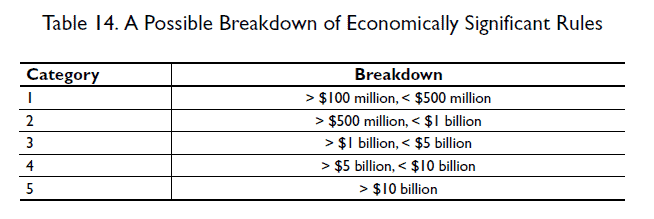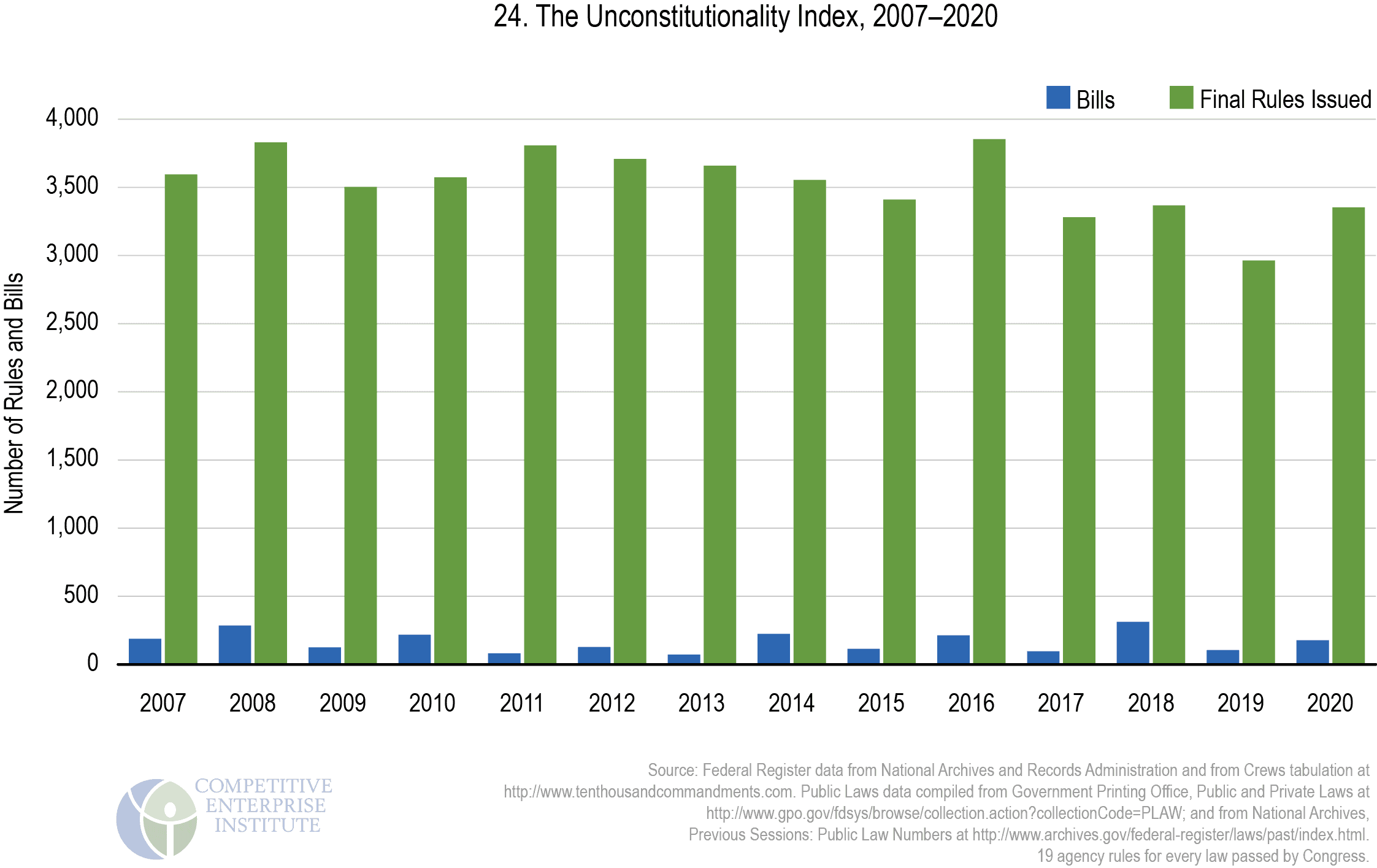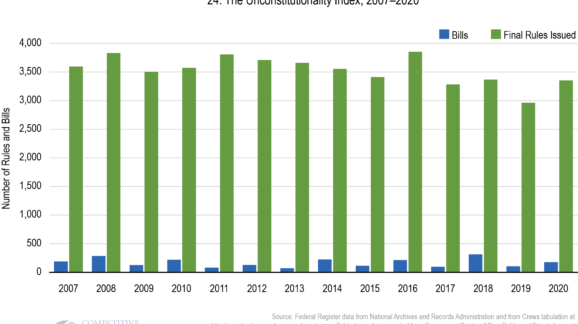Liberate to Stimulate
Ten Thousand Commandments 2021 - Chapter 10
Download Chapter 10 as a PDF
Policy makers frequently propose spending stimulus to grow or strengthen economies. That was certainly the case in the year of COVID-19. A regulatory liberalization stimulus, on the other hand, can offer confidence and certainty for businesses and entrepreneurs.
Sometimes, businesses value regulatory stability over streamlining of rules. “Why do so many CEOs welcome the seemingly hostile Biden’s victory?” asks Fortune’s Geoff Colvin.
The big, general reason many business leaders are fine with a President Biden is that they can’t take the tumult any longer. Business prizes stability, predictability, certainty. Trump’s incessant whipsawing on some of the largest issues—imposing tariffs, closing borders, retaliating against companies, leaving NATO—has exhausted businesspeople. As many of them say privately, they can compete so long as they know the rules, but can’t if the rules are constantly changing.
While there is value in stability, it need not be incompatible with regulatory streamlining. A future executive branch could take further steps beyond what Trump did on streamlining, such as requiring rules and guidance to be submitted to Congress and the GAO as required by the CRA. In addition, executive orders could (a) require review of independent agency rules, (b) reinstate principles for guidance document preparation and disclosure, and (c) ensure preparation of the annual aggregate regulatory cost estimate already required by law.
Improving Regulatory Disclosure
Certainly, some regulations’ benefits exceed costs under the parameters of guidance to agencies, such as OMB Circular A-4, but for the most part net benefits or actual costs are not subject to quantification. Without more thorough regulatory accounting than we get today—backed up by congressional certification of what agencies specifically do—it is difficult to know whether society wins or loses as a result of rules. Pertinent and relevant regulatory data should be compiled, summarized, and made readily available to the public. One important step toward better disclosure would be for Congress to require—or for the administration or OMB to initiate—publication of a summary of available but scattered data. Such a regulatory transparency report card could resemble some of the presentation in Ten Thousand Commandments.
Accountability is even more important than disclosure. Congress routinely delegates legislative power to unelected agency personnel. Reining in off-budget regulatory costs can occur only when elected representatives are held responsible and end “regulation without representation.” Stringent limitations on delegation, such as requiring congressional approval of rules, are essential.

As detailed earlier, regulations fall into two broad classes: (a) those that are economically significant or major (with effects exceeding $100 million annually) and (b) those that are not. Agencies tend to emphasize reporting of economically significant or major rules, which OMB also highlights in its annual regulatory reports. A problem with this approach is that many rules that technically come in below that threshold can still be very significant in real-world terms.
Under current policy, agencies need not specify whether any or all of their economically significant or major rules cost just above the $100 million threshold or far above it. One helpful reform would be for Congress to require agencies to break up their cost categories into tiers, as depicted in Table 14. Agencies could classify their rules on the basis of either (a) cost information that has been provided in the regulatory impact analyses that accompany some economically significant rules or (b) separately performed internal or external estimates.
Furthermore, much of the available but scattered regulatory information is difficult to compile or interpret. To learn about regulatory trends and acquire information on rules, interested citizens once needed to comb through the Unified Agenda’s 1,000-plus pages of small, multicolumn print. Fortunately, today it is easier to compile results from online searches and agencies’ regulatory plans and sites like Regulations.gov. Data from the Unified Agenda could be made still more accessible and user-friendly if elements of it were officially summarized in charts and presented as a section in the federal budget, in the Agenda itself, or in the Economic Report of the President. Suggested components of this Regulatory Transparency Report Card appear in Box 5.
In addition to revealing burdens, impacts, and trends, such a breakdown would reveal more clearly what we do not know about the regulatory state, for example, the percentage of rules for which their issuing agencies failed to quantify either their costs or benefits.
Furthermore, the accumulation of regulatory guidance documents, memoranda, and other regulatory dark matter to implement policy underscores the need for greater disclosure than exists now. These kinds of agency issuances can be regulatory in effect but are nowhere to be found in the Unified Agenda. Inventorying such dark matter is difficult, but formal attempts began in 2020 in response to Executive Order 13891 that are worth maintaining. Legislation such as the Guidance Out of Darkness Act would help address many of the shortcomings in guidance disclosure.
In addition, observers have little ability to distinguish whether rules are regulatory or deregulatory, beyond what was implemented by Executive Order 13771, with its “deregulatory” designation and the fiscal year-end “Regulatory Reform Results” reports. Similarly, future regulatory reforms should require regulatory and deregulatory actions to be classified separately in the Federal Register and for agencies’ confusing array of rule classifications to be harmonized. Current reporting distinguishes poorly between rules and guidance documents affecting the private sector and those affecting internal government operations. It also should be improved.

Building on these principles and basic frameworks, additional information could be incorporated as warranted—for example, success or failure of special initiatives such as executive branch restructuring or updates on ongoing regulatory reform or disclosure campaigns. Providing historical tables for all elements of the regulatory enterprise would prove useful to scholars, third-party researchers, members of Congress, and the public. By making agency activity more explicit, a regulatory transparency report card would help ensure that policy makers take the growth of the administrative state seriously.
Ending Regulation without Representation:
The “Unconstitutionality Index”—19 Rules for Every Law
Regulatory agencies do not answer to voters. Yet in a sense, regulators, rather than the elected Congress, do the bulk of U.S. lawmaking. As Columbia University legal scholar Phillip Hamburger has described, the rise of the modern administrative state runs counter to the Constitution, which “expressly bars the delegation of legislative power.” But agencies are not the primary offenders. For too long, Congress has shirked its constitutional duty to make the tough calls. Instead, it routinely delegates substantial lawmaking power to agencies and then fails to ensure that they deliver benefits that exceed costs.
The primary measure of an agency’s productivity—other than growth of its budget and number of employees—is the body of regulation it produces. Agencies face significant incentives to expand their turf by regulating even without established need. It is hard to blame agencies for carrying out the very regulating they were set up to do in the first place. Better to point a finger at Congress.

The “Unconstitutionality Index” is the ratio of rules issued by agencies relative to laws passed by Congress and signed by the president. In calendar year 2020, federal regulatory agencies issued 3,353 final rules, whereas the 116th Congress passed and President Trump signed into law 178 bills (the corresponding figure in 2019 was 105 bills). That means nearly 19 rules were issued for every law passed in 2020 (there were 28 in 2019 and 11 in 2018; see Figure 23).
The number of rules and laws can vary for many reasons, but the Unconstitutionality Index still provides some context, with anecdotes, about rules. The Unconstitutionality Index average over the past decade has been 28 rules issued for every law passed. However, in the Trump era’s streamlining context, the fact that eliminating a rule requires issuing a new one meant that the Index, ironically, was “worsened” by deregulation. (Appendix: Historical Tables, Part I, depicts the “Unconstitutionality Index” dating back to 1993 and shows the numbers of executive orders and the numbers of agency notices, which could arguably be incorporated into the Index.) Of course, rules issued by agencies are not usually related to the current year’s laws; typically, agencies’ rules comprise the administration of prior years’ legislative measures.
Mounting debt and deficits, now at unprecedented levels, can incentivize Congress to regulate rather than to increase government spending to accomplish policy ends. By regulating instead of spending, government can expand almost indefinitely without explicitly taxing anybody one extra penny. For example, if Congress wanted to boost job training, funding a program to do so would require legislative approval of a new appropriation for the Department of Labor, which would appear in the federal budget and increase the deficit. Instead, Washington could try to induce Fortune 500 companies to implement job training programs, to be carried out according to new regulations issued by the Department of Labor. The latter option would add little to federal spending but would still let Congress take credit for the program.
Moreover, agency guidance and executive orders now constitute a significant part of government activity, so non-legislative policy making should be a major issue of concern and subject to greater disclosure.
An annual regulatory transparency report card is needed, but is not the complete response. Regulatory reforms that rely on agencies policing themselves within the limited restraints of the Administrative Procedure Act will not rein in the growth of the regulatory state or address the problem of regulation without representation. Rather, Congress should vote on agencies’ final rules before rules become binding on the public. Affirmation of new major and controversial regulations would ensure that Congress bears direct responsibility for every dollar of new regulatory costs.
The Regulations from the Executive in Need of Scrutiny Act (REINS) Act (S. 68, 117th Congress) offers one such approach. It would require Congress to vote on all economically significant agency regulations. It passed the House in previous Congresses but has not moved forward in the Senate. To avoid getting bogged down in approving myriad agency rules, Congress could vote on agency regulations in bundles. Another way to expedite the process is via congressional approval or disapproval of new regulations by voice vote rather than by tabulated roll-call vote. What matters most is that members of Congress go on record for the laws the public must heed.
If Congress does not act, states could step in. The Constitution provides for states to check federal power, and pressure from states could prompt Congress to act. Many state legislators have indicated support for the Regulation Freedom Amendment, which reads, in its entirety: “Whenever one quarter of the members of the U.S. House or the U.S. Senate transmit to the president their written declaration of opposition to a proposed federal regulation, it shall require a majority vote of the House and Senate to adopt that regulation.”
Congressional—rather than agency—approval of regulatory laws and their costs should be the main goal of reform. When Congress ensures transparency and disclosure and finally assumes responsibility for the growth of the regulatory state, the resulting system will be one that is fairer and more accountable to voters. Legislative regulatory reform and executive branch streamlining are parts of more fundamental debates. Congress is responsible for the fiscal budget, yet deficits remain the norm. The larger questions are over the role and legitimacy of the administrative state and the role of government in a constitutional republic.
